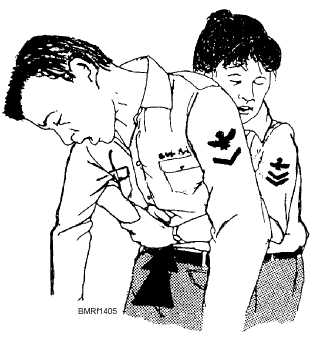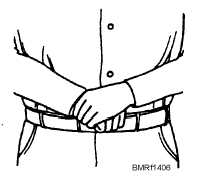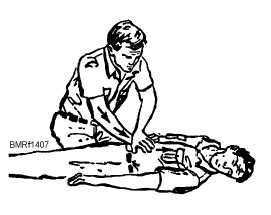14-7
PROCEDURE
STEPS
Standing abdominal thrust
1.
2.
3.
Stand behind the victim and wrap your arms around the victim’s waist (fig. 14-5).
Grasp your wrist and place the thumb side of your fist against the victim’s abdomen,
above the navel and just below the rib cage (fig. 14-6).
Give four quick upward thrusts to the victim. The obstruction should pop out like a
champagne cork. If unsuccessful, repeat until the obstruction is dislodged.
Reclining abdominal thrust
1.
2.
Position yourself for the thrust by either straddling the victim at the hips, straddling
one leg, or kneeling at the victim’s hips.
Place your hands one on top of the other in the area between the lower end of the
sternum and the navel, and give four quick upward thrusts into the abdomen, as
shown in figure 14-7.
Standing chest thrust
1.
2.
3.
Bring your arms under the arms of the victim and encircle the lower chest, as shown
in figure 14-8.
Grasp your wrist, keeping the thumb side close to the victim’s chest. (Keep your fist
on the middle, not the lower part, of the sternum.)
Press the chest with a sharp, backward thrust.
Reclining chest thrust
1.
2.
Kneel at either side of the victim, place hands in same position as used for CPR.
Deliver thrusts slowly and downward on the sternum (fig. 14-9).
Figure 14-5.—Position for standing abdominal thrust.
Figure 14-6.—Correct hand positioning.
Figure 14-7.—Position for reclining abdominal thrust.





